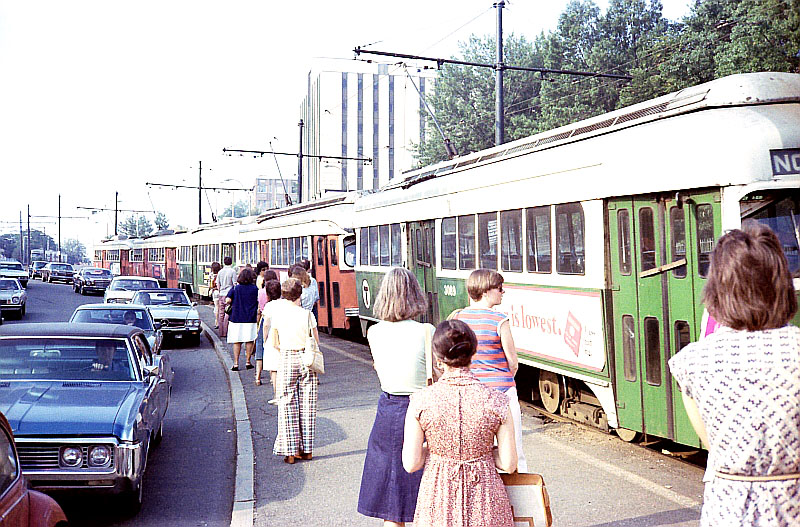Re: Driven By Customer 'Service' Parte Dos
This is a big problem at Northeastern too. The platforms are way too long and they're about 200' shorter (420') than that +600' distance from Pleasant to Babcock.
It also doesn't help the signal priority. You get more precise fine-tuning the closer a stop is to the actual traffic signal (i.e. grade crossing), with offset platforms at the crossing being most ideal when it's possible to do up the platforms that way.
The optical sensors under consideration for Beacon St. and presumably here work this way:
-- Sensor pointed at track detects the shape of a trolley or bus (rules out false positives), and its distance from the sensor by how big/small the telltale shape is.
-- Sensor also reads the wavelengths of the indicator lights on the front/back of the vehicle to tell if the train or bus is coming or going, and if doors are open or closed (i.e. flashing or steady).
So...in an 'ideal' setup at offset platforms the trolley approaches the grade crossing + platform from a distance, sensor detects the shape, and the computer gets put on notice that a station stop and signal change may be imminent. Then when doors open on-platform and the indicator lights on the trolley go from steady to flashing the signal immediately triggers a red light on Comm Ave. and a prioritized walk signal at the crosswalk so people can cross the street while the trolley is there. Doors shut...indicator lights go steady. Signal triggers a prioritized green on Comm Ave.
-- Much safer because no rider with ants-in-pants standing on the other side of the crosswalk has to worry about missing the train, or have to jaywalk to make the train. They get conditioned to wait because they'll always get a walk signal when the train's at the station and the operator will always know to keep the doors open for the duration of the walk signal.
-- Much less dependent on variable dwell times. The signal computer doesn't have to guess in advance how long the doors are going to be open, and the operator doesn't have to play hurry-up with waving passengers on and start to panic because the station dwell is spilling over-long. The sensor just waits for the indicator lights to go from flashing to doors-closed steady...THEN fires an immediate yellow+red on the side street and a green on Comm. Ave. Perversely, this HELPS their stubborn insistence on front-door-only boarding and fare recovery because the operator isn't under pressure to start waving people on for free to make schedule.
-- At the crossing the signal timings don't have to build in cushion for a signal change as much as they would if the trolley were mid-block. Depending on how they set it (and especially if the side street is a minor one) they can just change the signal immediately upons doors-close instead of building in a longer lag for fudge factor.
-- It works at stepped-up levels because of the shape detectors and the indicator detectors. An express train running skip-stop can get a loose prioritization on shape detection alone. That is, the train is this close but the marker lights aren't changing as if this is going to be a station stop...so signal computer makes assumption that this train is 1) running express, or 2) nobody's on the platform or made a stop request onboard and thus flag-stop rules are in effect. Basically, it's the same way the sensors would work at a traffic light that has no station stop, except it can change its assumptions at a station stop by detecting the trolley's behavior on approach.
All of this works when it's mid-block or facing-platform, but it's not as precise and there has to be more padding for uncertainty by the sensor the further the trolley stops from the traffic light. So "PleasantBabcock" is going to be a lot more approximate a guessing game under signal priority than, say, Harvard Ave. with its offset platforms. Babcock's a high-volume intersection, so it kind of blunts the edge a little.
Obviously there are some stops where facing platforms or mid-blocks are unavoidable due to space constraints. Blandford. BU East because of Blandford Yard on the other side of the Granby St. crossing. Brigham Circle. Those C stops between Summit Ave. and Washington. But generally if there's nothing preventing offset platforms at a traffic signal, go for offset platforms at a traffic signal (offsets also allow for wider platforms in most cases).
This seems to be unnecessarily muddying up the signaling waters for somebody's aesthetic preferences. Comm Ave. has to be timed to its most brutally efficient between BU Bridge and Packards because of the pain those intersections are to cross under heavy load. There may be no more important stops on the whole line to optimize signaling to the fullest than these right here because that's your recovery time for delays/bunching crossing Packards and the Bridge. Keep it simple, stupid.



